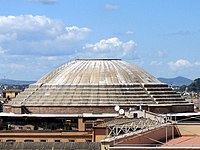
Photo from wikipedia
A large amount of waste slurry is produced during the construction of pipe jacking projects. To avoid the waste slurry occupying too much urban land, it needs to be rapidly… Click to show full abstract
A large amount of waste slurry is produced during the construction of pipe jacking projects. To avoid the waste slurry occupying too much urban land, it needs to be rapidly reduced. Due to the complex composition of waste slurry, the existing dewatering methods face the problem of low efficiency, and the soil after dewatering is difficult to recycle as soil materials due to high water content and low strength. There is currently a lack of research on dewatering and resource utilization of waste slurry from pipe jacking projects. In response to this problem, this paper studies the flocculation-settling characteristics of waste slurry and the mechanical properties of solidified sediment. It was found that the anionic polyacrylamide (APAM) 7126 obtained the best separation effect if the waste slurry contains bentonite, which increases the zeta potential, resulting in poor separation. Thus, FeCl3·6H2O and APAM 7126 can be used as compound conditioners. The sediment after settling was further added with 20–30% sulphate aluminum cement (SAC), and the unconfined compressive strength of the solidified sediment for 3 days could exceed 30 kPa. After flocculation-settling and solidification treatment, the waste pipe jacking slurry can be quickly dewatered into a soil material with a certain strength, which provides a reference for engineering applications.
Journal Title: Materials
Year Published: 2022
Link to full text (if available)
Share on Social Media: Sign Up to like & get
recommendations!